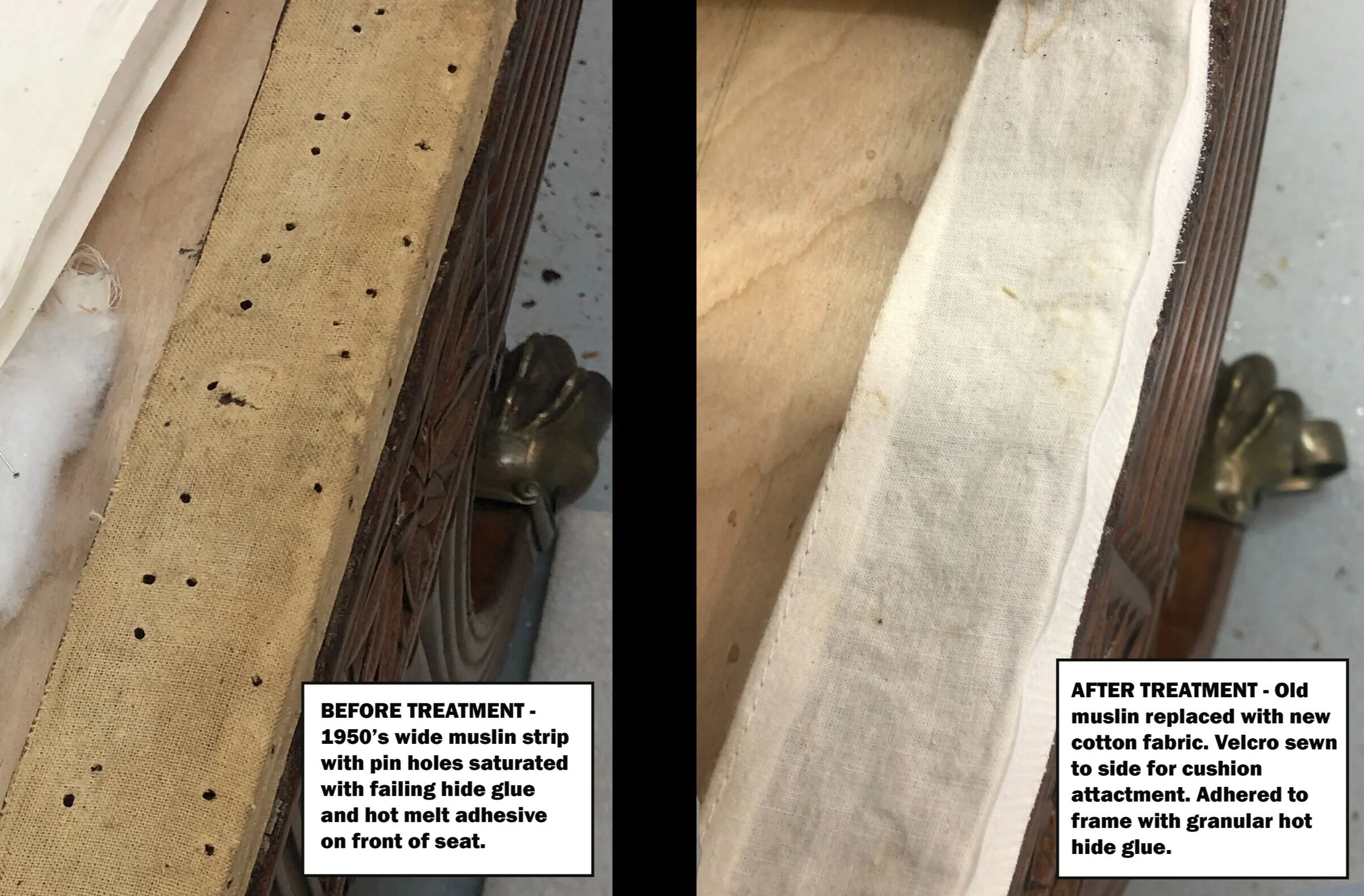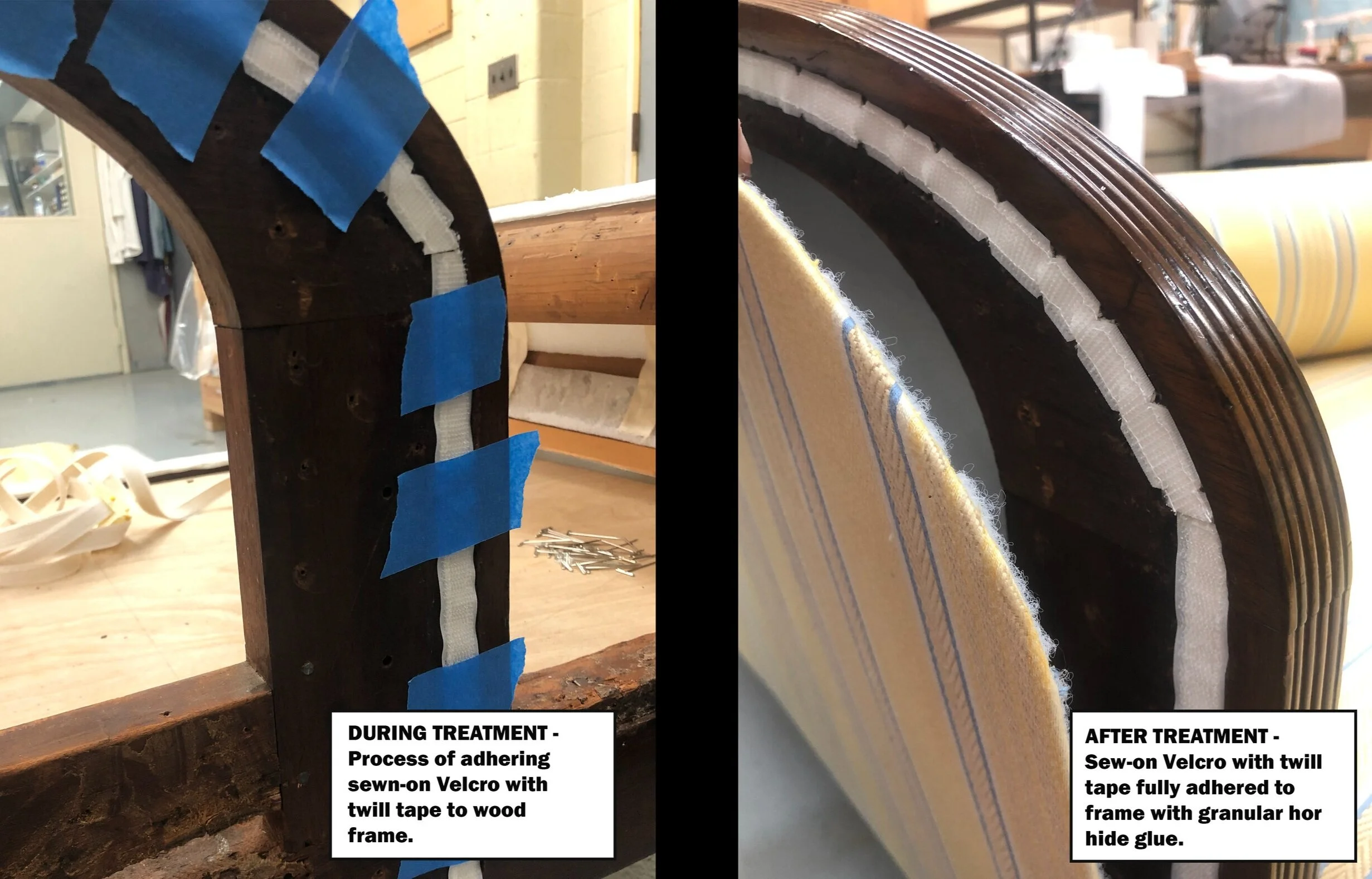Grecian Couch
(Object ID: 35.79.41)
Project Duration: 64 Hours
Date: 1810-1820
Dimensions: Height: 33.125in Width: 89in Length: 25.75in
Materials: Mahogany (Wood), Maple (Wood), Cotton (Textile), Brass (Alloy)
Condition:
Object is in good condition overall, with no current structural issues. Previous treatment to the front proper left leg remains successful. The additional two central legs that were added for stabilization show no signs of weakness, though the item is still considered unsafe to place weight on.
All fabric (a newer replacement textile for the earlier upholstery which had dated back to 1950) is all intact, with little to no fraying at the edges. The cushioning and batting that lines the footrest and headrest of the object is depleted; batting was formerly connected to the cotton fabric using large amounts of hot melt adhesive. This has caused the cushioning to be lumpy in select locations, mostly near the edges. All cushioning is connected to the bench frame using either hot melt adhesive or T-pins, while the textile is connected to the frame using Velcro which has since collectively failed.
In the most recent treatment to the object, all upholstery was made detachable using hook and loop Velcro tape and cotton based twill tape (Before this treatment, the upholstery had been nailed to the frame using hundreds of small pins). The use of pins has created substantial pitting in the wood, most notably on the headrest.
While this decision to use a safer, reversible upholstery detachment was sensible, the method of doing so has failed structurally on the entire item. Twill tape had been adhered to edges of the frame using granulated hot hide glue and acted as a barrier between the wood and the Velcro. Older muslin strips of fabric remain on the headrest and wide front edge of the object and are greatly degraded.
The Velcro tape was then attached to the cotton based twill tape using hot melt adhesive or Nano silicone grip tape. It appears that the slick, nylon material of the Velcro inhibited a strong bond from forming with either the hot melt adhesive or the grip tape, causing it to detach from the twill tape and fail. Sections that were attached via an adhesive have not held, while all sewn on Velcro has remained structurally sound.
Treatment:
The pitted edges of the headrest were filled with a mixture of granulated hot hide glue and sawdust (1:1 mixture) to make them more stable for the new twill tape/Velcro. To prevent the Velcro from failing more immediately, a new method was used. Initially, it was evident that mechanically sewn on Velcro provided the strongest bond while still being a fully reversible treatment. Additionally, the use of granulated hot hide glue to attach the initial twill tape was successful overall. The new method of attachment combines these two techniques to make for a durable, yet reversible Velcro adhesion to the wood frame.
This new technique consisted of directly sewing ⅝ in. Velcro Brand (Hook side) to ¾ in. cotton twill tape, then attaching those strips to the wood frame using granular hot hide glue. To do this, each length where velcro was needed on the object was individually measured and notated in a diagram for future treatment needs (See Image). Strips of cotton twill tape and sew-on Velcro were then cut according to those measured individual lengths and then mechanically sewn together on their perimeters. In total, 25 strips of sewn twill tape/Velcro were made and attached onto the wood frame with granular hot hide glue. For the wide front edge of the object that had a strip of muslin, a new wide strip of cream cotton fabric was cut to size and attached using granulated hot hide glue.
For portions of the upholstery that could not be sewn, a different method of adhesion was employed. Rather than using a hot melt adhesive, it was decided that an industrial strength adhesive be used instead that is more impermeable to high temperatures and humidity. Clear E6000 (mainly composed of tetrachloroethylene) was used to attach ⅝ in. Velcro Brand (Loop side) to the backside of the upholstery. Additional Velcro strips were sewn into the footrest upholstery fabric to create a more seamless shape without the use of pins.
The cushioning and batting were completely replaced with new cream cotton fabric and batting. The pieces were lightly hand sewn together throughout and mechanically sewn on the perimeter. Velcro (Loop side) was added to select locations to remove the need for large amounts of pins and make for easier assembly/disassembly.


